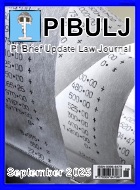June 2013 Contents
 Welcome to the June 2013 issue of PI Brief Update Law Journal. Click the relevant links below to read the articles and take the CPD quiz. Please remember to fill in our quick feedback form after you have finished. Welcome to the June 2013 issue of PI Brief Update Law Journal. Click the relevant links below to read the articles and take the CPD quiz. Please remember to fill in our quick feedback form after you have finished. CPD Quiz The quiz is designed to meet the CPD requirements of the SRA and provides 1.5 hours accredited distance learning. Law Brief Publishing Ltd is registered with the Solicitors Regulation Authority for England and Wales, ref EGB/LBPL. The CPD is also valid for cILEX (formerly ILEX) members and for members of the Chartered Insurance Institute (CII). Please check with the relevant organisation for full details of their CPD rules. Take the CPD Quiz Feedback Form CPD Information |
|
| Personal Injury Articles | |
 The Duty to Secure Young Children In Proper Child Restraint Seats - Jonathan Watt-Pringle QC The Duty to Secure Young Children In Proper Child Restraint Seats - Jonathan Watt-Pringle QC The decision in Williams v. Estate of Dayne Joshua Williams [2013] EWCA Civ 455 has confirmed that the well-known principles in Froom v Butcher [1976] QB 286 apply equally to contribution proceedings against parents who fail to secure their children in appropriate child restraint seats. |
 Extensions of Time in the New (Post-Jackson) World - Robert Vernon, 9 Park Place Chambers Extensions of Time in the New (Post-Jackson) World - Robert Vernon, 9 Park Place Chambers The High Court (in the guise of Edwards-Stuart J sitting in the Technology and Construction Court) has recently provided one of the first insights into the approach to be taken by the courts to applications for relief from sanctions in the post-Jackson era. |
 The Last Gasp for Strict Liability? - Colm Nugent, Hardwicke The Last Gasp for Strict Liability? - Colm Nugent, Hardwicke With the Government's amendment to the Enterprise Bill 2013 due to abolish strict liability in employers' claims, it seems that certain Courts were ahead of the pack in seeking to mitigate what [they?] saw as the potentially unfair consequence of construing the Regulations too strictly against quasi-employers. |
 Animals Act 1971, Strict liability and Statutory Defences - Caroline Wood, Sovereign Chambers Animals Act 1971, Strict liability and Statutory Defences - Caroline Wood, Sovereign Chambers Leeds County Court considered the application of S 2(2) of the Animals Act and the defences in the case of Preskey v Carl Sutcliffe (1) Emma Sutcliffe (2) LTL 25.3.2013, Document no. AC0136. |
 Keith Barker v. Lancashire County Council [2013] EWCA Civ 582 - Daniel Tobin, 12 King's Bench Walk Keith Barker v. Lancashire County Council [2013] EWCA Civ 582 - Daniel Tobin, 12 King's Bench Walk At approximately 5.30pm on 29th October 2007 the Claimant ('C') tripped and fell on a raised cobblestone in the surrounding area of a tree pit in Henderson Street, Preston. The Defendant ('D') was the relevant highway authority for the purposes of the Highways Act 1980. |
 Editorial: The Scope and Interpretation of Part 18 - Aidan Ellis, Temple Garden Chambers Editorial: The Scope and Interpretation of Part 18 - Aidan Ellis, Temple Garden Chambers Part 18 is one of the shortest Parts of the Civil Procedure Rules. Rule 18(1) simply provides that at any time the Court may order a party to "clarify" or "give additional information" in relation to "any matter which is in dispute in the proceedings". It is nevertheless a significant provision... |
 Limitation, Discretion and the Burden of Proof - Andrew Roy, 12 King's Bench Walk Limitation, Discretion and the Burden of Proof - Andrew Roy, 12 King's Bench Walk Case Comment: Sayers v Chelwood (Deceased) and Chelwood [2012] EWCA Civ 1715; [2013] 2 All E.R. 232; [2013] P.I.Q.R. P8. This case helpfully provides a final answer to the question whether a Claimant seeking under s33 Limitation Act 1980 to disapply the s11 statute bar should face a very heavy burden in doing so. The answer, in short is, no. |
 Pesonal Injury Trusts and Tax Planning - Alan Robinson, Cross Keys Associates Pesonal Injury Trusts and Tax Planning - Alan Robinson, Cross Keys Associates Originally a personal injury trust was simply a method of sheltering compensation paid to someone as a result of personal injury. For someone receiving means tested benefits, this would mean that the compensation did not form part of their capital for benefit purposes, and they would therefore not be caught by the maximum capital rules. |
 Wall v Mutuelle: Exploring the Limits of the Applicable Law Under Rome II - Frances McClenaghan, 1 Chancery Lane Wall v Mutuelle: Exploring the Limits of the Applicable Law Under Rome II - Frances McClenaghan, 1 Chancery Lane The recent case of Wall v Mutuelle De Poitiers Assurances ([2013] EWHC 53 (QB)) sheds light on the ambit of the applicable law under Rome II (Regulation (EC) No 864/2007 of the European Parliament and of the Council of 11 July 2007 on the law applicable to non-contractual obligations). |
 Beware... or Be Sued! - Paul Stanton Beware... or Be Sued! - Paul Stanton Thirteen years ago, the Woolf Reforms (allegedly) heralded a "Brave New World" for civil litigation. The intention was to give Judges significant control of cases, and prevent claims being delayed unnecessarily. Issuing proceedings was intended to be a last resort. The consequences of default would be Draconian. The sound of Practitioner's knees knocking together could be heard up and down the jurisdiction. Then... |
 Liability for Defective Premises - Andrew Roy, 12 King's Bench Walk Liability for Defective Premises - Andrew Roy, 12 King's Bench Walk The Defective Premises Act 1972 ("DPA") is an important but frequently misunderstood cause of action for personal injury claims. This article aims to provide an introduction to claims under the Act, and in particular to provide a practical overview of when and how the DPA applies... |
 A Brave New World: Personal Injury Practice Post-Jackson - Amanda Yip QC, Exchange Chambers A Brave New World: Personal Injury Practice Post-Jackson - Amanda Yip QC, Exchange Chambers The last few months have not been an easy time for personal injury lawyers but I believe the response to the Jackson reforms is encouraging. The speed with which we were required to assimilate and adjust to major rule changes presented a challenge but, by and large, PI lawyers are a practical bunch and we have risen to that challenge. |
 Privatising the Courts: Things Can Only Get Better? - Thomas Crockett, 1 Chancery Lane Privatising the Courts: Things Can Only Get Better? - Thomas Crockett, 1 Chancery Lane "Err... sorry but, we have your skeleton argument, but the Judge says he doesn't have any other documents from the Defendant. It seems half the court file has been lost". This was the lament from a very long-suffering court usher to the author just recently ahead of a Fast Track trial. |
 The Return of Fettes v Williams? - Zachary Weaver-Shojaie, MWG Solicitors The Return of Fettes v Williams? - Zachary Weaver-Shojaie, MWG Solicitors The issue of impecuniosity has already gained notoriety for its lack of a certain definition. With varying approaches taken within Lagden v O'Connor itself, the issue has been one open to debate and is often reliant on the Court's involvement for settlement. Since Lagden, many have awaited a more certain definition. This has, to date, remained outstanding, and it is submitted that convolution, rather than clarification, is on the horizon. |
 Access to Justice Must Be Preserved - Dr Victoria Handley, Director of Handley Law Limited Access to Justice Must Be Preserved - Dr Victoria Handley, Director of Handley Law Limited Lord Neuberger President of the Supreme Court this week gave a strong warning that the cuts being made to legal aid and to the cost of litigation are likely to have a knock-on effect to the cost of the courts. Finally judges are speaking up to defend the rule of law. It's a welcome voice in these Post-Jackson days. |
 The Sharp End of Employers' Liability - Breach and Causation Under the Personal Protective Equipment Regulations 1992 - Andrew Roy, 12 King's Bench Walk The Sharp End of Employers' Liability - Breach and Causation Under the Personal Protective Equipment Regulations 1992 - Andrew Roy, 12 King's Bench Walk The Chief Constable of Hampshire Police v Taylor [2013] EWCA Civ 496. This case provides a telling illustration of the stringency of the Personal Protective Equipment Regulations 1992 ("the PPE Regulations") and the evidential difficulties a Defendant is likely to face rebutting liability under health and safety regulations. |
 Personal Injury Overseas and the Problem of Jurisdiction - Matthew Chapman, 1 Chancery Lane Personal Injury Overseas and the Problem of Jurisdiction - Matthew Chapman, 1 Chancery Lane Michael Wink v Croatio Osiguranje DD [2013] EWHC 1118 (QB) (Haddon-Cave J). This case arose out of a road traffic accident in Croatia on 5 September 2009. The Claimant, a UK national domiciled in England, was on holiday with his wife when the accident happened. |
 Building a Comprehensive Argument for Claimants - Bill Braithwaite QC, Head of Exchange Chambers Building a Comprehensive Argument for Claimants - Bill Braithwaite QC, Head of Exchange Chambers A phrase I like using to all those involved on the claimant's side of a catastrophic personal injury claim is: "How can we help the defence lawyers and insurer to see the real nature of the problems suffered by the Claimant?". |
 Contributing to Litigation - Marc Rivalland, 1 Chancery Lane Contributing to Litigation - Marc Rivalland, 1 Chancery Lane In Onay v Brown [2009] EWCA Civ 775, the Defendant car driver admitted liability and consented to the entry of judgment against him, the sole remaining issue on liability being whether the Claimant motorcyclist was speeding and/or... |
 Insurers to the Rescue - Julie Carlisle, Boyes Turner Insurers to the Rescue - Julie Carlisle, Boyes Turner The Government has apparently decided to wait until later this year to make a decision upon whether to increase the small claims limit for PI claims from £1,000 to £5,000. In the meantime APIL research suggests that such an increase would push 70% of PI cases into the Small Claims Process. Disaster? |
 Caselaw Since 1st April 2013 - Leopards and Spots? - Ian Miller, 1 Chancery Lane Caselaw Since 1st April 2013 - Leopards and Spots? - Ian Miller, 1 Chancery Lane The case of Venulum Property Investments Ltd v Space Architecture Limited [2013] EWHC 1242 (TCC) concerned a relief from sanctions application under r. 3.9. The decision was in fact made under the old rules because the application was made prior to 1st April... |
 When Is It Appropriate to Rely on an Employment Expert?: A consideration of Turner v Walsall Hospital NHS Trust [2013] EWHC 1221 (QB) - Pritesh Rathod, 1 Crown Office Row When Is It Appropriate to Rely on an Employment Expert?: A consideration of Turner v Walsall Hospital NHS Trust [2013] EWHC 1221 (QB) - Pritesh Rathod, 1 Crown Office Row Since the advent of the CPR, the use of employment experts has declined. Whereas it was once common in personal injury claims to adduce evidence from an employment consultant as to the likely career path that a claimant was going to... |
 Rare s 33 Success for Defendants - Ivor Collett, 1 Chancery Lane Rare s 33 Success for Defendants - Ivor Collett, 1 Chancery Lane Cynical defendant lawyers regard applications under s 33 of the Limitation Act to extend time for bringing personal injury proceedings as invariably going the claimants' way. Some see it as effectively a statutory abolition of the limitation period. |
 Expertly Selecting Experts - Bill Braithwaite QC, Head of Exchange Chambers Expertly Selecting Experts - Bill Braithwaite QC, Head of Exchange Chambers Selecting experts in catastrophic injury claims crops up again and again - not surprisingly, because they are so important. It is always interesting, though, to see their different approaches to problems in... |
 Jackson Reforms in Litigaton Procedure and the Competent Medico-Legal Expert - Giles Eyre, 9 Gough Square Jackson Reforms in Litigaton Procedure and the Competent Medico-Legal Expert - Giles Eyre, 9 Gough Square The new rules will force lawyers to take a close look at the economics of presenting an injury claim and how most efficiently to put the claim together. Medical reports remain essential to such a claim, providing, as they do, the foundations of much of the claim... |
 Instructing a Photographer: Practice Points From a Clinical Photography Expert - Tim Zoltie, Director of Clinical Photography UK & Clinical Photographer at Leeds Teaching Hospitals Instructing a Photographer: Practice Points From a Clinical Photography Expert - Tim Zoltie, Director of Clinical Photography UK & Clinical Photographer at Leeds Teaching Hospitals A photograph of an injury can be a powerful and effective tool in its ability to depict severity, and its subtle ability to evoke a sympathetic understanding of suffering and pain which would otherwise be difficult to portray... |
 Referees & Liabilities - John van der Luit-Drummond Referees & Liabilities - John van der Luit-Drummond Examining the liabilities of match officials for catastrophic injuries arising in sport following the leading cases of Smoldon v Nolan, and Vowles v Evans. |
 Summary of Recent Cases, June 2013 Summary of Recent Cases, June 2013 Here is a summary of the recent notable court cases over the past month. |
 PI Practitioner, June 2013 PI Practitioner, June 2013 Each issue a particular topic is highlighted, citing some of the useful cases and other materials in that area. This month: Wasted Costs. |
|
| Medico-Legal Articles, Edited by Dr Hugh Koch | |
 Sleep Problems in Children After Road Traffic Accidents and Their Relationship Between Ptsd and Mothers' Ptsd Symptoms - Dr Kathryn Newns Sleep Problems in Children After Road Traffic Accidents and Their Relationship Between Ptsd and Mothers' Ptsd Symptoms - Dr Kathryn Newns Sleep disorders in children can manifest themselves immediately after a trauma, and have been found to continue years following the traumatic incident (Glod, Teicher, Hartman, & Harakal, 1997). An interesting relationship has been found between sleep problems in children and the traumatic symptoms experienced by the mother of the child following an RTA. |
|
| Expert Witness Articles | |
 Compensation Culture Prompts Move to Accreditation for Medical Expert Witnesses - Mark Solon, Bond Solon Compensation Culture Prompts Move to Accreditation for Medical Expert Witnesses - Mark Solon, Bond Solon Should claimants continue to have the whip hand? The Government's recent consultation paper, Reducing the number and cost of whiplash claims, stresses the need for better medical evidence. In response, Cardiff University Law School has launched its Medico-Legal Foundation Certificate for expert witnesses in association with Bond Solon Training. |
|











![Appeal judge rules that credit hire company has no costs liability following a finding of fundamental dishonesty in personal injury case: RSA v. Fastrack Solutions Limited [2023] 4 WLUK 92 - David Bowden, Erimus Chambers](/content/images/resized/images/stories/carkeys_72_72.jpg)


